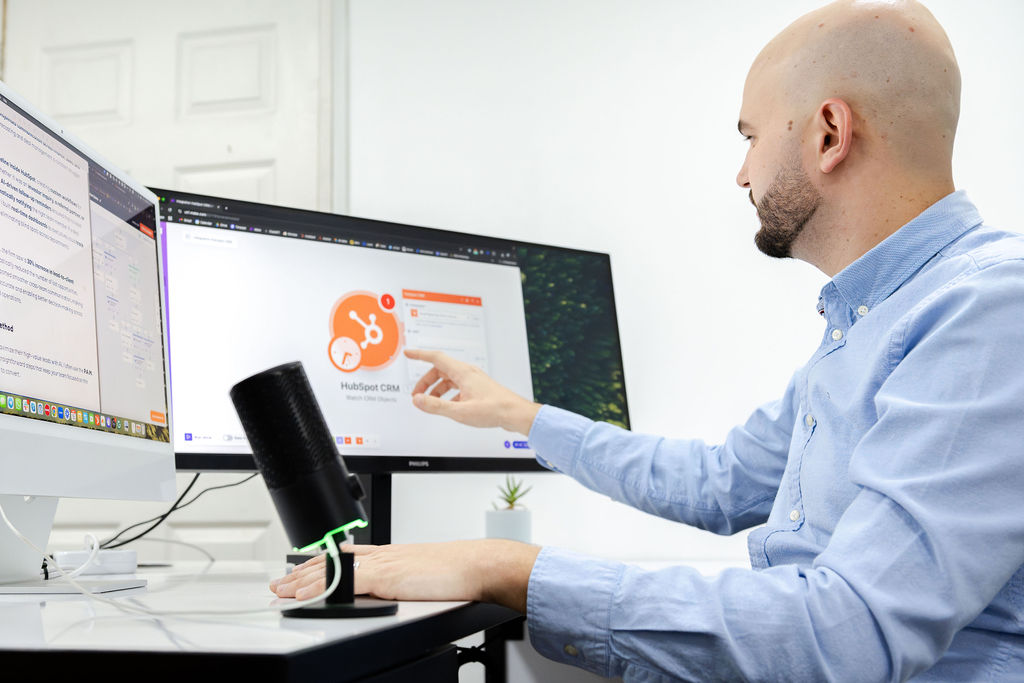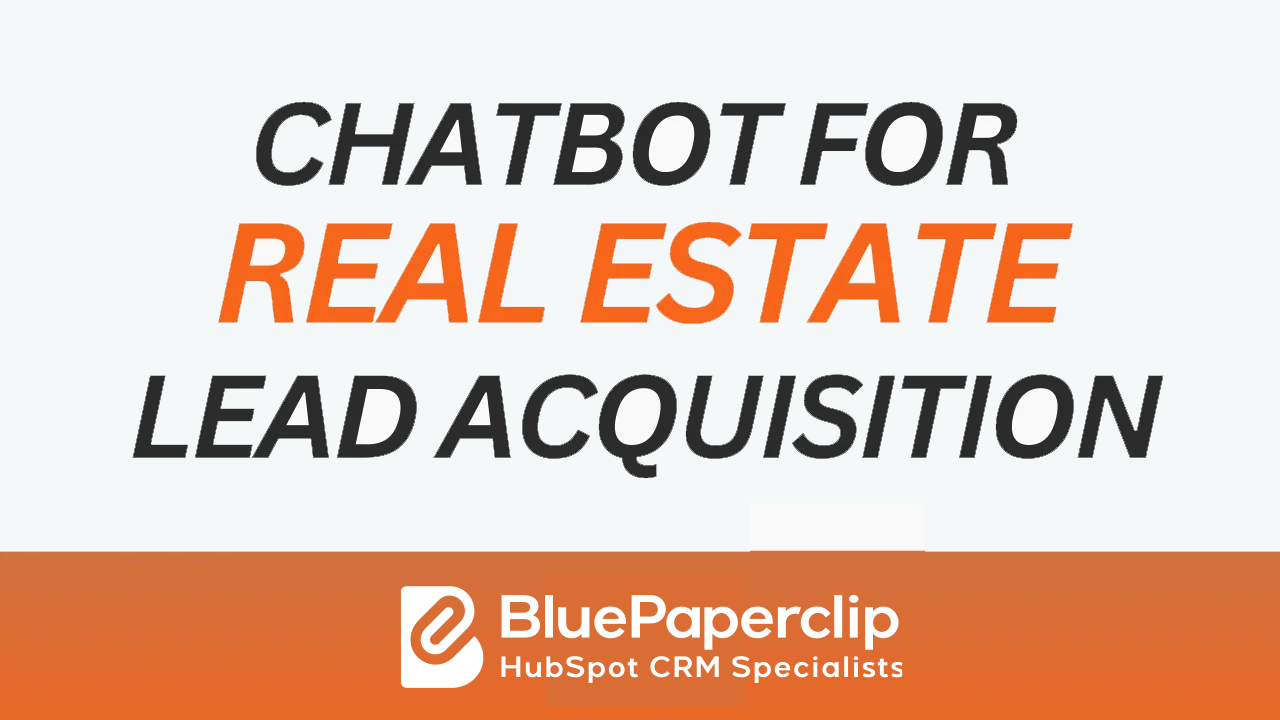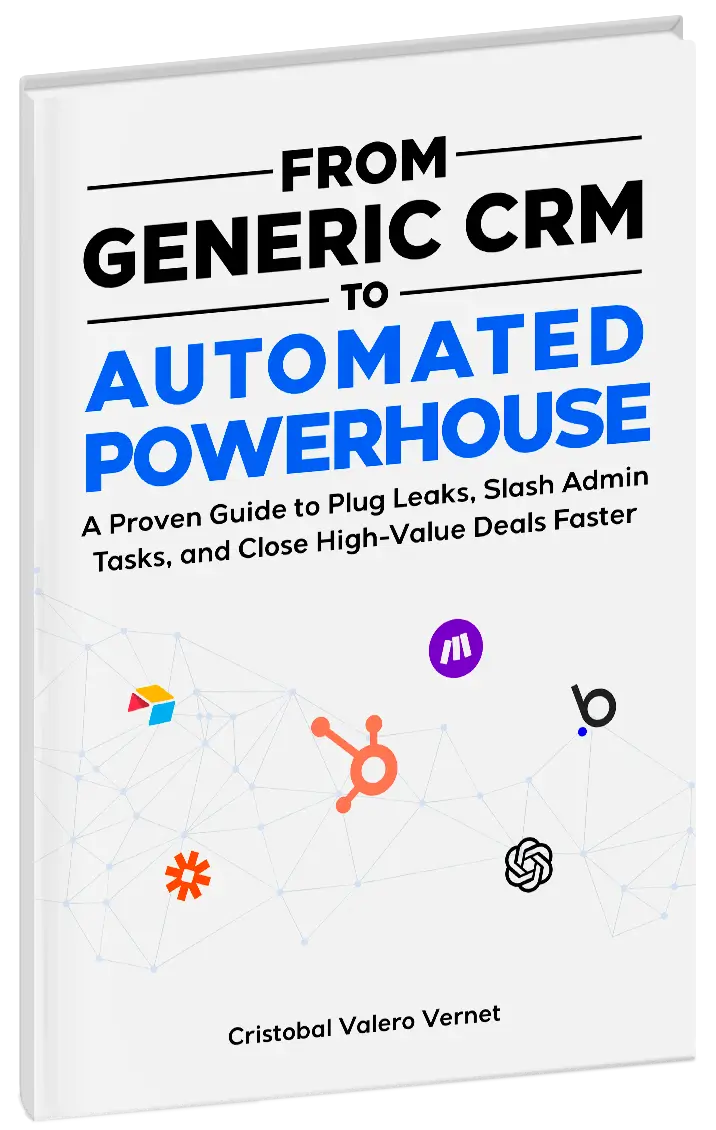Let’s be real, slapping a one-size-fits-all CRM onto your business and calling it a day just doesn’t cut it. What really makes a difference is tweaking those CRM deal stages to perfectly match how your team operates from the ground up.
Whether you’re a startup gearing up to shake up the market or a seasoned player fine-tuning your sales process, getting your HubSpot CRM deal stages just right can make a world of difference.
Your sales process’s deal stages are directly linked to your company’s performance. If you’re finding it tough to close deals, it might be because your sales process and deal stages aren’t in sync, or they could be creating hurdles for your leads.
Maybe you’re just starting to integrate a CRM system to boost and automate your marketing and sales efforts. Either way, setting up the right deal stages can turn struggles into success.
This isn’t just about picking stages; it’s about making your CRM feel like it was custom-built for you and your team. In this piece, we’ll explore how to fine-tune your sales strategy and shape your deal stages in HubSpot CRM.
In this article, you’ll find the best and most crucial tips and recommendations from HubSpot. Are you getting started in HubSpot? Or are you a long-time HubSpot user looking for some guidance? Either way, this article is for you!
Ready to dive into the specifics and get your CRM deal stages perfectly aligned? Let’s get started!
First of all… What are HubSpot Deal Stages?
Navigating the twists and turns of a sales pipeline can feel overwhelming without a solid game plan. That’s where HubSpot, a top player in inbound marketing and sales software, comes to the rescue with its customizable deal stages in the CRM system.
This feature doesn’t just help businesses streamline their sales processes; it also ensures they can track the journey of each deal from start to finish effectively.
HubSpot deal stages are essential components of the sales pipeline, providing a clear visual of all sales activities. Each stage represents a step in the sales journey, from the initial contact with a potential customer to the final decision. The beauty of these stages is their flexibility—they can be tailored to fit your specific sales process perfectly.
It’s not merely about tracking progress; it’s about molding the CRM to align seamlessly with your workflow. Let’s explore how these customizable deal stages can elevate your sales efficiency and success. Ready to revolutionize your sales process?
The Importance of Custom CRM Deal Stages
Why bother customizing deal stages in your CRM? Well, every business has its unique rhythm when it comes to sales. What works for one might be completely off for another.
By setting up your CRM deal stages—like HubSpot’s—to match your sales process, you’re essentially programming your system to mirror the actual steps your team takes to turn leads into customers. This not only boosts your team’s efficiency but also gives you clearer insights into your sales pipeline, helping you pinpoint where deals get stuck and why.
When your CRM aligns perfectly with your sales process, your team naturally becomes more efficient. Salespeople spend less time figuring out how to categorize their interactions and more time engaging with potential clients. Each stage of your customized deal flow can prompt the necessary actions from the team, ensuring no critical steps are overlooked.
Moreover, a customized CRM setup provides deeper insights into your sales pipeline. It becomes much easier to analyze where most prospects drop off or stall and investigate why. Is there a particular stage where deals frequently stagnate? Are there patterns suggesting a need for a change in approach or additional training for your team? These questions become straightforward to address when your CRM reflects your actual sales process.
These insights are invaluable for continuously refining your sales strategies. For example, if many prospects drop out at the proposal stage, a deeper analysis might reveal the need for more compelling proposal content or better follow-up strategies. HubSpot CRM’s analytics can highlight these trends, guiding you to make informed improvements that enhance both your sales process and customer satisfaction.

Optimizing Your Sales Pipeline
Creating a Sales Pipeline tailored to your business or product is the first step in optimizing your sales process. Before implementing and outlining the stages in HubSpot CRM, it’s essential to have a clear understanding of what those stages are in your Sales Pipeline.
Your sales process is represented in HubSpot by your deal pipeline. Therefore, it’s crucial to clearly define both your sales pipeline and your deal stages in HubSpot, as they form the backbone of your sales strategy.
Create a Sales Pipeline
The first step to optimizing your sales process is creating a Sales Pipeline tailored specifically to your business or product. Before implementing and outlining the stages in HubSpot CRM, you need a clear understanding of what those stages are in your Sales Pipeline.
In essence, your sales process will be represented in HubSpot by your deal pipeline. Therefore, it’s crucial to clearly define both your sales pipeline and your deal stages in HubSpot, as they form the backbone of your sales strategy.
To help you get started, let’s look at what a standard sales pipeline might look like. Keep in mind that every business, product, and process is unique, so feel free to customize this to best fit your needs. Let’s dive in.
Here’s a standard sales pipeline process, listed step-by-step with brief definitions for each stage. According to HubSpot, this list represents the key stages in a sales pipeline from the seller’s perspective, guiding them through the process of turning a prospect into a satisfied customer:
1. Identify Prospect: Locate and identify potential customers who may benefit from the product or service.
2. Connect with Prospect: Initiate contact with the potential customers through various communication methods such as email, phone calls, or social media.
3. Schedule Meeting: Arrange a preliminary meeting or call to discuss the prospect’s needs and how the product can meet them.
4. Demo Product: Conduct a demonstration of the product to show its features, benefits, and how it addresses the prospect’s specific needs.
5. Follow Up: Reach out to the prospect after the demo to address any questions, provide additional information, and gauge interest.
6. Schedule Meeting with Team: Organize a meeting involving key members of both the prospect’s and seller’s team to discuss details and requirements.
7. Educate Team: Provide the prospect’s team with detailed information and training about the product, focusing on its use and benefits within their specific context.
8. Send Contract: Send a formal contract to the prospect outlining the terms of the purchase, pricing, and other legalities.
9. Follow Up: Follow up on the sent contract, address any final concerns, and negotiate any terms if necessary.
10. Sign Contract: Closed Won: Finalize the sale as the contract is signed by the prospect, marking the successful closure of the deal.
Now that we have the first steps from a seller’s perspective, it’s necessary to look at the steps from a buyer-centric perspective.
Steps from the buyers perspective on your CRM deal stages:
1. Schedule a Meeting: Initiate a meeting with the seller to learn about the product and discuss potential fit with your needs.
2. Explore Product: Participate in a product demonstration to understand the features, benefits, and potential value it could bring to your organization.
3. Discuss Offering with Team: Share insights and information about the product with your team to gather feedback and make a collaborative decision.
4. Schedule Meeting with Team: Organize a comprehensive session with your team to delve deeper into the product’s details and implications for your operations.
5. Team Evaluates: Conduct an internal evaluation involving all necessary stakeholders to assess the product’s suitability, benefits, and costs.
6. Approve Purchase: Gain the necessary approvals from the decision-makers within your organization to proceed with the purchase.
7. Sign and Return Contract: Finalize your commitment by signing the contract and returning it to the seller, thereby agreeing to the terms and initiating the purchase process.
Remember: these steps are very standardized for what a sales pipeline should look like, but it can vary slightly according to each business, product, or needs. Feel free to tailor your sales pipeline to fit the vision of your business.
Let’s refine your sales pipeline
Once we have outlined all the processes in your sales pipeline, HubSpot recommends refining it to achieve maximum efficiency. We’ll trim any unnecessary steps from your CRM’s deal stage to create your perfect sales pipeline.
Remember, HubSpot recommends that your deal stages should be as specific and streamlined as possible to make the sales process much more effective and successful with the platform
Let’s take the list of buyer-centric steps we reviewed in the previous section and start trimming boldly:
First, let’s make sure your pipeline starts in the right place… That’s why we’re going to forget about the first two steps of “Identify Prospect” and “Connect with Prospect.” Why? Because these steps aren’t measurable. Your sales reps might identify a bunch of prospects, and eventually, your sales pipeline could become completely congested with unqualified prospects, wasting your reps’ time and ultimately slowing down the entire process for your business or product.
Now, let’s look at the step of “Scheduling a Meeting.” This is the perfect step to start your sales pipeline and then reflect it in your deal stages. If your sales rep and the prospect agree to a meeting to discuss your services, it sounds like a great sales opportunity.
Before moving forward, we need to focus on the steps from a buyer-centric perspective. HubSpot states that an effective sales pipeline should be created from a buyer-centric standpoint. Therefore, we will disregard the previously mentioned steps from the seller’s perspective.
So, your sales pipeline is shaping up like this. We are focusing on the buyer-centric steps. We’ve removed the first two steps, and we’ve established your initial starting step:
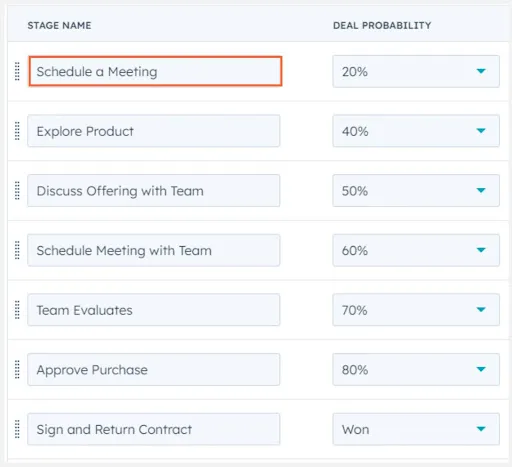
Once we have the first and crucial step in place, let’s continue refining the process. For this, we’ll use four criteria to determine the necessary steps for a deal stage pipeline. Each step must meet these standards:
- Required
- Buyer-centric
- Factual
- Inspectable
Let’s review each criterion and trim the steps that do not match.
Required
This criterion focuses on steps that your reps must take in every sale, without exception. These are steps your reps should not skip. For your own pipeline, ask yourself: “If one of my sales reps skips this step, would it ruin the prospect’s experience or make the process fail or become inefficient?”
With our first defined step of “Scheduling a meeting,” let’s move to the second: “Explore Product”.
Once we’ve had the meeting with the prospect, it’s crucial that you perform a product demo and the prospect explores and understands whether it is beneficial or not. This step is necessary in the process; the buyer must have the opportunity to check or test the product or service to decide whether to proceed with the purchase. Similarly, the seller will have the opportunity to qualify the prospect to determine if they are a customer likely to buy. Skipping this step would be disastrous for the entire process, so we keep it.

In the next step, the buyer will “Discuss Offering with the Team.” If you are selling a product or service that needs to be reviewed and evaluated by a team or group, then this step cannot be skipped or omitted. Therefore, we will also keep this step.
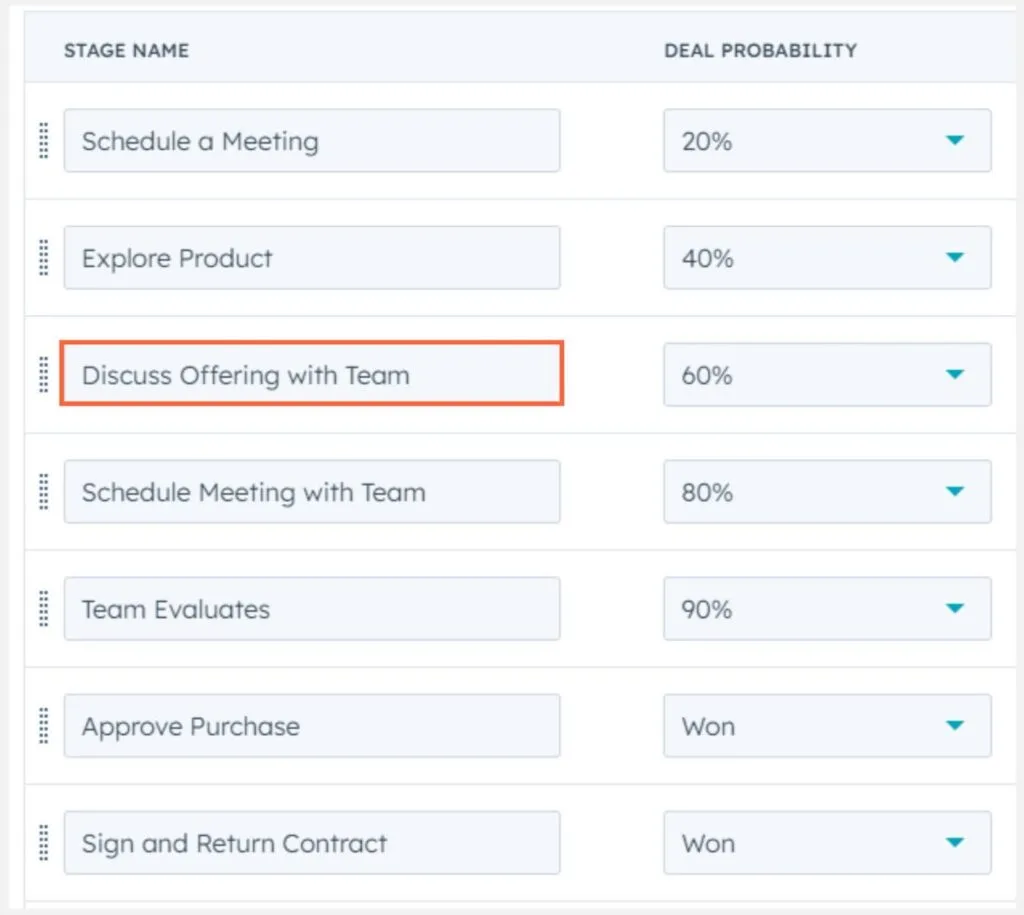
Next, we have “Schedule Meeting with Team.” Depending on who managed the first meeting or the outcome of that initial encounter, this step may have already been effectively covered during the first meeting. Furthermore, if you have a well-integrated and automated system for meeting links that allows your prospects to book meetings with you, there’s no reason to have a step that takes up valuable time to schedule a meeting. So, we’ll say goodbye to this step.
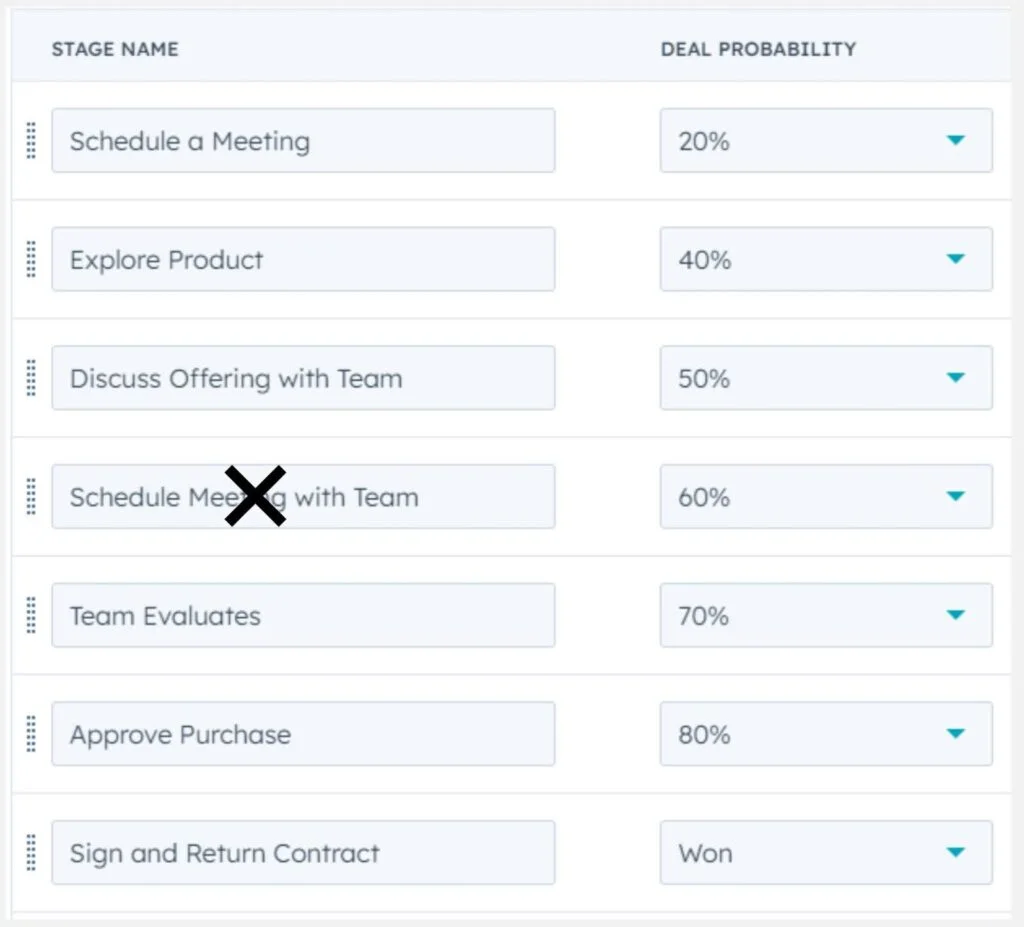
In the next step, the buyer “Evaluates.” This step is crucial as it may be the moment where you negotiate the price of your product or service with your prospect, where the prospect resolves any doubts about your service, or where you agree on the terms of the contract to be signed. If that’s the case, you won’t want to skip this step, so we’ll keep it.
Next, from the buyer’s side, the decision-maker will approve the purchase of your product or service, a step that is absolutely essential for you. Similarly, the next step on the seller’s side is “Send Contract,” which leads to the final and most important point in the sales pipeline: “Sign and Return Contract.” This is when your prospect officially becomes a customer after going through the entire sales process we’ve crafted.
Thus, we will retain these last three steps:

We now have the essential steps for your deal stage pipeline, but we need to refine them a bit more to turn them into your perfect deal stage pipeline. We still need to review three other fundamental criteria to establish the stages.
Buyer-centric:
This term refers to steps in the sales process that are designed from the perspective of the buyer or prospect. Buyer-centric stages focus on ensuring that the needs, preferences, and experiences of the buyer are prioritized throughout the sales journey.
This approach helps in creating a more personalized and effective interaction, aiming to increase customer satisfaction and the likelihood of closing a sale.
Factual:
A step that’s tied to a specific action rather than being based on a feeling. You don’t want your sales reps managing your leads based on hunches or “measures” that are not quantifiable. You want your pipeline to be grounded in actual actions with real metrics to ultimately close the sale.
Each time a step is completed, you want a clear yes or no, not subjectivity or a lot of interpretation.
Inspectable:
An inspectable step can be verified by a record in your CRM. Many aspects on the buyer’s side are beyond your control or verification, which is why you need steps that are firmly within your team’s control.
Let’s finish the review on the steps
Now, let’s review all your CRM deal stages steps under these last three criteria mentioned:
The first remaining step is “Schedule a Meeting,” which is completely Factual—either you organize a first meeting with your prospect, or you don’t. It’s also Inspectable because a record will be left in your calendar and CRM. It’s also Buyer-centric because both the seller and especially the buyer agree on a first meeting.
The second step we have is “Demo Product.” This step is Factual as it requires actual action from both the seller and the buyer. It is also Inspectable because at a minimum, the seller will record in the CRM how the meeting went.
The next step is “Discuss Offering With Team,” and while this step is important, Factual, and Buyer-centric, it is not Inspectable because there is no way for you to know how, when, and where your prospect is discussing your offer and product. Therefore, we will remove it:
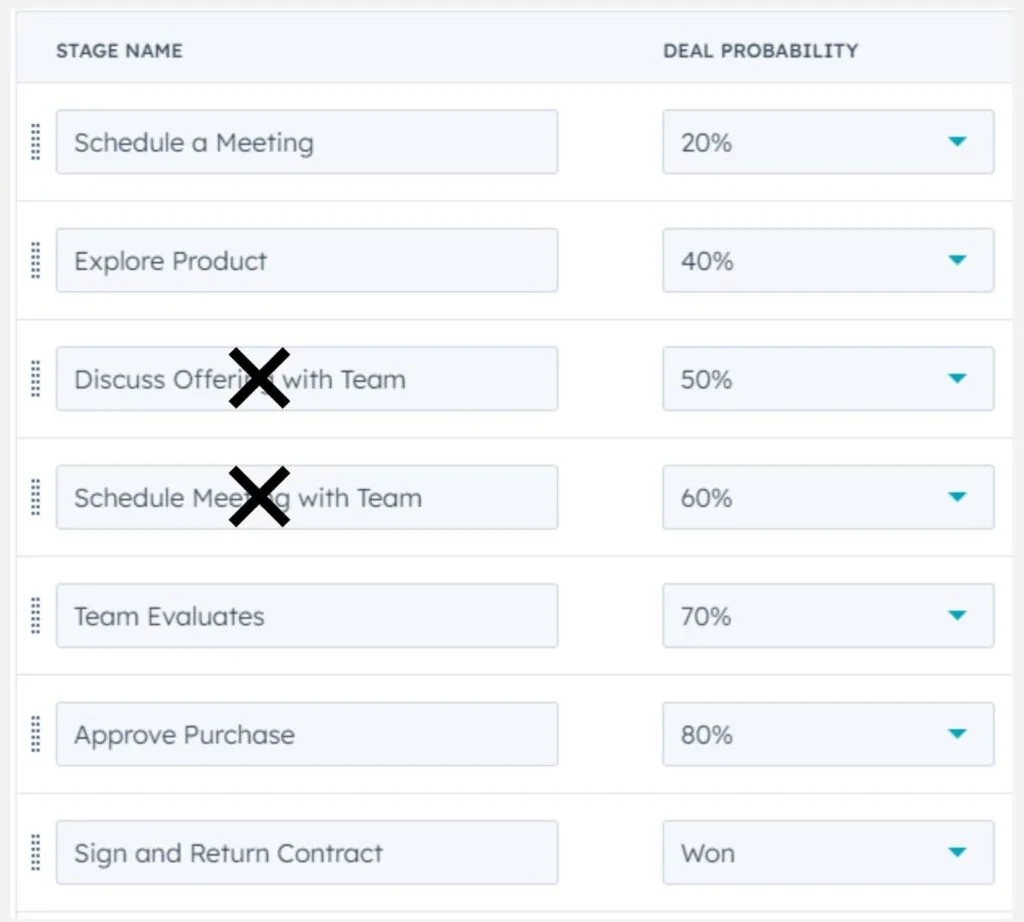
Next, we have the second meeting with the prospect, where the buyer evaluates your product or service. This step meets all the previously mentioned criteria, so we will keep it and simply name it “Team Evaluates”:
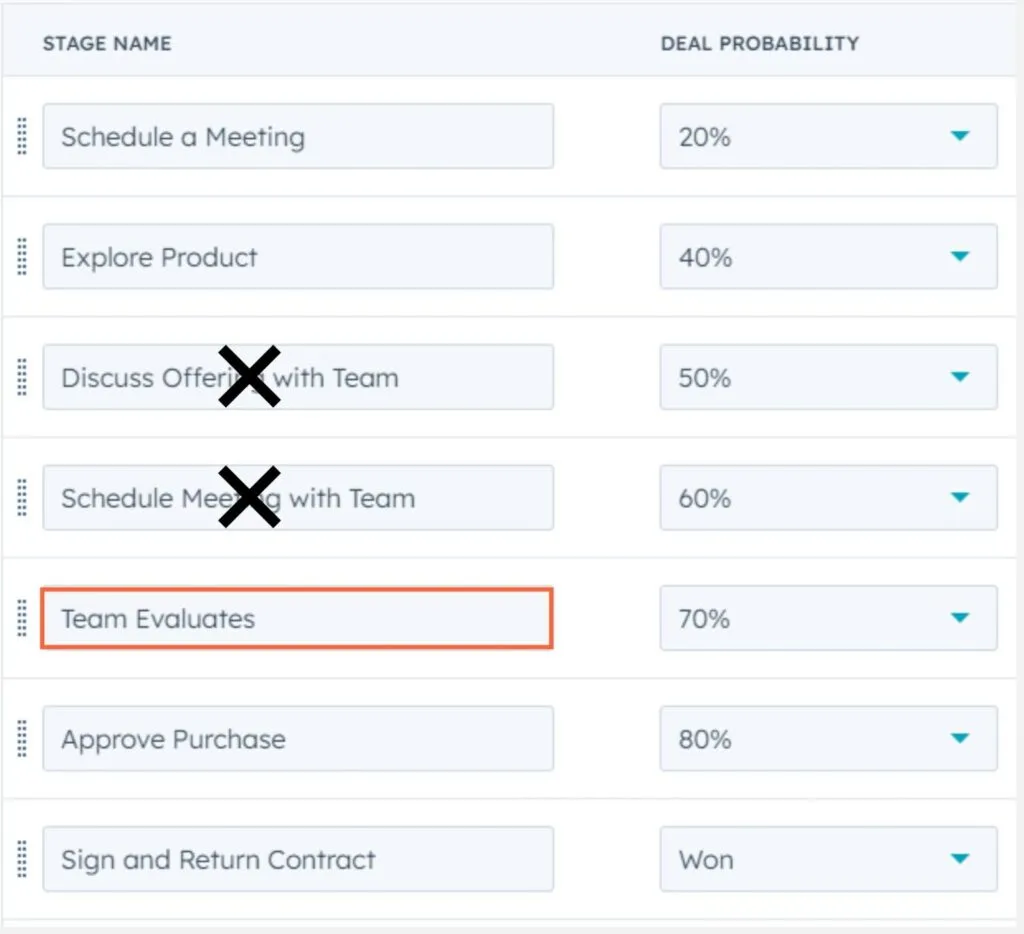
We continue with the step of “Approve Purchase” by your prospect, which from the start is neither Factual nor Inspectable, as the decision-making cannot be recorded at this point and we cannot know factually how it occurred. We will remove it:
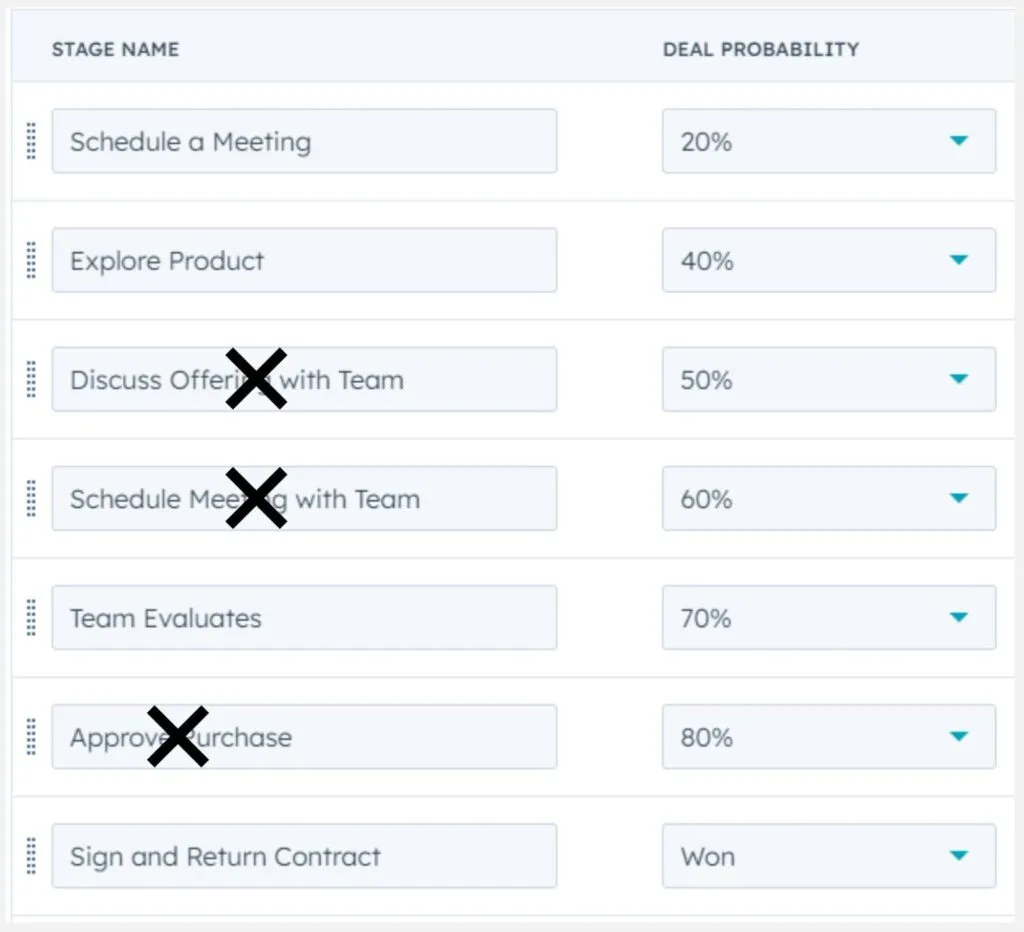
Next, the “Send Contract” step meets the initial criteria, but it only applies from the seller’s side and is not buyer-centric. Therefore, what we’ll do in this case is adjust the step to be from the buyer’s perspective, which would be “Contract Received.” This way, it will meet the essential criteria we have set to work with:
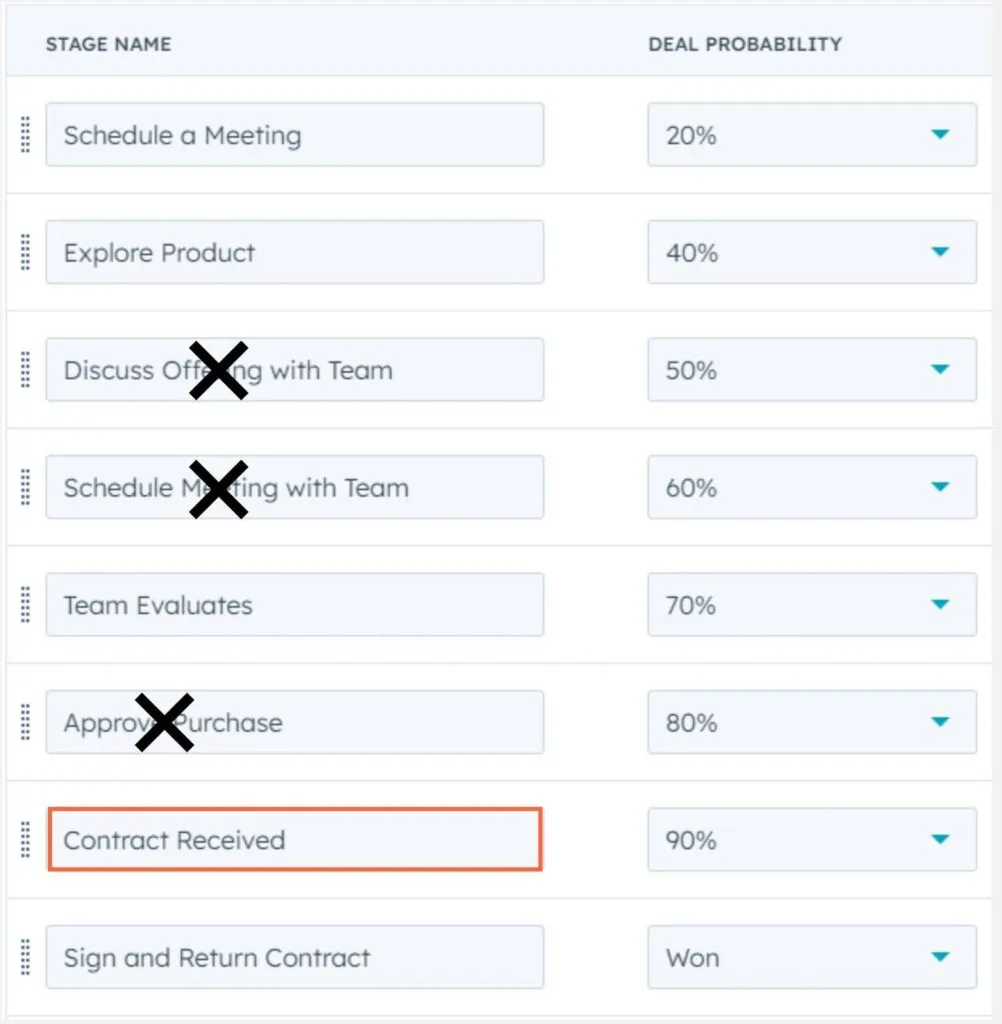
And the final step of “Sign and Return Contract” meets all the previous criteria and is also the crucial closing step with your prospect.
We have streamlined this process from 12 steps down to 5 basic and essential steps for your deal stage pipeline. Once cleaned up and polished, it will look like this:
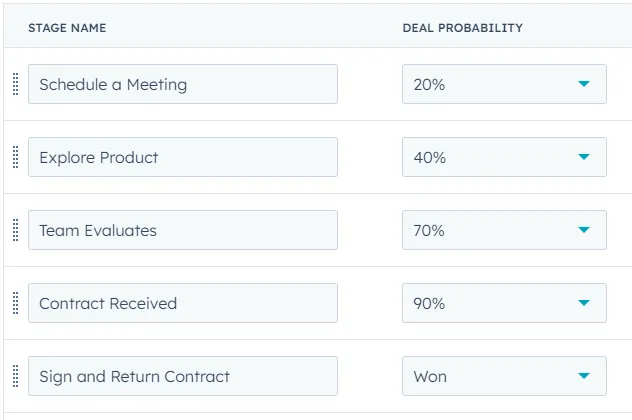
Much better, right? Now we have a clean and efficient process, where you and your prospect will first have a meeting, then your lead can explore your product or service, evaluate whether to proceed with the purchase after a second contact with you, receive a contract to then sign it and close the transaction with you.
This is what an excellent sales pipeline looks like. If you can streamline and reduce it as we did here, specific to the needs of your business, you’ll have an efficient and functional sales pipeline, perfect for your business.
Ready to take your HubSpot deal stages and business to the next level? Let’s make it happen—get to know us better or book a call!


